Delhi and Agra
Saturday 8 January – Tuesday
11 January 2000
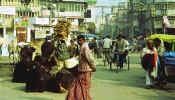 The morning after we arrived in
Delhi, there was another tearful goodbye to Jerry as he left to make his way
back to London and we continued our journey across India.
We spent two days in Delhi, sightseeing, shopping and feeling miserable
in the cold, damp weather. Our
feel-good therapy was to pay ridiculous prices for good old home food at the
Pizza Express in town, which certainly helped to lift our spirits on the long,
foggy nights. We had recently discovered that Pippa was pregnant and already
she had begun to feel nauseous, a feeling that lasted throughout the day and
was
The morning after we arrived in
Delhi, there was another tearful goodbye to Jerry as he left to make his way
back to London and we continued our journey across India.
We spent two days in Delhi, sightseeing, shopping and feeling miserable
in the cold, damp weather. Our
feel-good therapy was to pay ridiculous prices for good old home food at the
Pizza Express in town, which certainly helped to lift our spirits on the long,
foggy nights. We had recently discovered that Pippa was pregnant and already
she had begun to feel nauseous, a feeling that lasted throughout the day and
was exacerbated by the smells she encountered daily out on the streets.
Everything from the food being cooked at roadside stalls to the piles of
rotting debris and cow dung assaulted her senses; this was not the best place in
the world to be when your sense of smell suddenly became overly heightened.
exacerbated by the smells she encountered daily out on the streets.
Everything from the food being cooked at roadside stalls to the piles of
rotting debris and cow dung assaulted her senses; this was not the best place in
the world to be when your sense of smell suddenly became overly heightened.
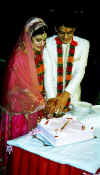 We had already visited the Red
Fort, the Jama Masjid (the Great Mosque) and the Chandni Chowk (main bazaar) in
Old Delhi on our trip to India the previous year, but still wanted to explore
several other sights that we had not had time to check off our list.
The first of these was Humayun’s Tomb, built in the mid-16th
century and a wonderful early example of Mughal architecture.
The elements in its design (a squat building with
We had already visited the Red
Fort, the Jama Masjid (the Great Mosque) and the Chandni Chowk (main bazaar) in
Old Delhi on our trip to India the previous year, but still wanted to explore
several other sights that we had not had time to check off our list.
The first of these was Humayun’s Tomb, built in the mid-16th
century and a wonderful early example of Mughal architecture.
The elements in its design (a squat building with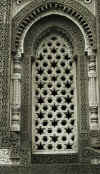 high arched entrances,
topped by a bulbous dome and surrounded by formal gardens) were to be refined
over the years to the magnificence of the Taj Mahal in Agra.
high arched entrances,
topped by a bulbous dome and surrounded by formal gardens) were to be refined
over the years to the magnificence of the Taj Mahal in Agra.
Another place on our must-do list was the
Qutab Minar Complex, one of the fine examples of early Afghan architecture from
the 12th century. A high, soaring tower of victory, the
sandstone and marble structure bore a slight resemblance to the Leaning Tower of Pisa.
At the base was the first mosque to be built in India, many elements of
which indicated its Hindu or Jain origins. On
Fridays, entrance to the monuments across Delhi were free and on that day, as well
as at the weekends, it seemed to be a popular family outing to visit these
complexes, dressed up in Sunday best to wander aimlessly around paying
almost no attention whatsoever to the actual monuments themselves.
the monuments across Delhi were free and on that day, as well
as at the weekends, it seemed to be a popular family outing to visit these
complexes, dressed up in Sunday best to wander aimlessly around paying
almost no attention whatsoever to the actual monuments themselves.
Most of the mosques, monuments
and forts that depicted India’s Muslim history could be found in Old Delhi.
The tightly packed streets, narrow alleys and constant traffic jams made
for challenging sightseeing. The
other half of Delhi, labeled as New Delhi, was built by the British as the
imperial capital of India and in contrast was much more open and spacious with
tree lined streets and parks. These
two distinct centres gave Delhi the feel of a large, sprawling city which was not
particularly pedestrian friendly. There
were continuous obstacles to navigate your way around, whether they were cows,
rickshaws, tuk-tuks and other traffic or the persistent vendors or locals trying
to sell something or con you in the latest Delhi scam.
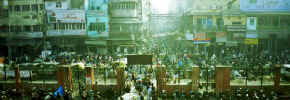
After two days, we were ready to
leave. Delhi may be a great city to
explore, but it’s best done in small doses.
Besides, we were heading for one of the ultimate tourist spots of all
time: the Taj Mahal.
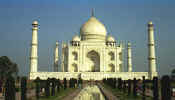 A train ride south from Delhi
was
Agra, the capital of India during the 16th and 17th
centuries. Agra was built on the
western bank of the Yamuna River (now an open sewer and recently declared as
being incapable of supporting any life form), and is home to what has been
described as the most extravagant monument ever built for love.
Although most people go there solely to see the Taj Mahal, Agra also
boasts a magnificent fort and a handful of other imposing monuments together
with the usual hoard of rickshaw-wallahs and thick pollution.
A train ride south from Delhi
was
Agra, the capital of India during the 16th and 17th
centuries. Agra was built on the
western bank of the Yamuna River (now an open sewer and recently declared as
being incapable of supporting any life form), and is home to what has been
described as the most extravagant monument ever built for love.
Although most people go there solely to see the Taj Mahal, Agra also
boasts a magnificent fort and a handful of other imposing monuments together
with the usual hoard of rickshaw-wallahs and thick pollution.
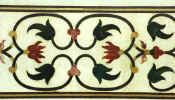 The Taj
was in fact a mausoleum,
built by the Emperor Shah Jahan in memory of his second wife who died in
childbirth in 1631. It was not
completed until 1653 despite the employment of over 20,000 people in its construction.
It is said that many of the artisans who worked on it later had their
hands or thumbs amputated to ensure that nothing as perfect as the Taj could
ever be repeated. As impressive
as it is from a photograph, the Taj was all the more impressive in person, in
part because you could take it in from a variety of perspectives, and in part
because of the many details that could only be appreciated up close.
The Taj
was in fact a mausoleum,
built by the Emperor Shah Jahan in memory of his second wife who died in
childbirth in 1631. It was not
completed until 1653 despite the employment of over 20,000 people in its construction.
It is said that many of the artisans who worked on it later had their
hands or thumbs amputated to ensure that nothing as perfect as the Taj could
ever be repeated. As impressive
as it is from a photograph, the Taj was all the more impressive in person, in
part because you could take it in from a variety of perspectives, and in part
because of the many details that could only be appreciated up close.
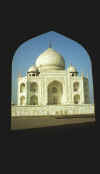

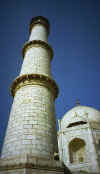
Even amid the crowds of people,
the splendor of the Taj Mahal was breathtaking. It seemed as
if wherever you looked there was something to impress. We saw it on an average day and it was pretty packed.
Also there during our visit was a film crew and cast filming the latest
“Bollywood” (the name for the local film industry) spectacle soon to be
aired in cinemas across India. This was definitely as big a draw card for the crowd as the
Taj.
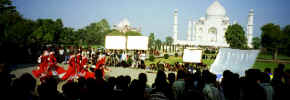
For a different view, we walked downriver to the Agra Fort and climbed up onto the ramparts to
look across the Yamuna River and watch the Taj Mahal ignited by the setting sun.
It proved to be a great photo shoot, as well as a great tour of the fort!
The massive walls contained a maze of buildings that formed a city within a city.
Its mosques, palaces and towers were the most impressive of any fort we
had seen.
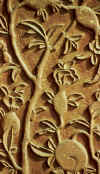
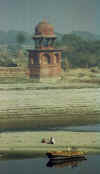
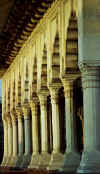
Fatapur Sikri and Bharatpur Bird Sanctuary
Wednesday 12 January &
Thursday 13 January 2000
 We left Agra in the rain and
took a bus to Fatapur Sikri to visit the deserted 16th century capitol of the Mughal empire.
This fortified city lay along the top of a high ridge and housed a
mosque that was said to be a copy of the one at Mecca.
The old city also retained a number
of
We left Agra in the rain and
took a bus to Fatapur Sikri to visit the deserted 16th century capitol of the Mughal empire.
This fortified city lay along the top of a high ridge and housed a
mosque that was said to be a copy of the one at Mecca.
The old city also retained a number
of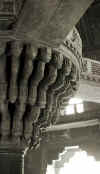 palaces and buildings containing a blend of Hindu and Muslim styles.
Some of the walls were made entirely of stone latticework, said to be
some of the finest examples of such work anywhere in the country.
palaces and buildings containing a blend of Hindu and Muslim styles.
Some of the walls were made entirely of stone latticework, said to be
some of the finest examples of such work anywhere in the country.
We spent the best part of the
day at Fatapur Sikri before taking another bus on to Bharatpur.
Neither of us would ordinarily call ourselves bird spotters but for some
reason, the Bharatpur Bird Sanctuary had caught our attention. A UNESCO World Heritage-listed wildlife reserve, we decided that if we were to
visit any of the National Parks during our tour of India, this one would be it.
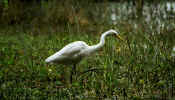 We were visiting the sanctuary
in January when many of the migratory birds were there, including the highly-endangered Siberian Crane. That was
the upside. The downside was that
during the winter months the weather can be cold and wet (which is was) and with
the high probability of fog and low cloud, our photographic talents would be
stretched to their limit (which they were).
But the cold was not to dampen our spirits. We hired bicycles and binoculars from our guesthouse and set
off early (complete with packed lunch) to bird spot to our heart’s content.
We were joined by two Canadian ladies and together with a guide managed
to check off over 50 species of birds by late afternoon.
We were all desperate for a glimpse of the one and only pair of Siberian
Cranes, but the closest we could get to them was a couple of white blobs through
the binos.
We were visiting the sanctuary
in January when many of the migratory birds were there, including the highly-endangered Siberian Crane. That was
the upside. The downside was that
during the winter months the weather can be cold and wet (which is was) and with
the high probability of fog and low cloud, our photographic talents would be
stretched to their limit (which they were).
But the cold was not to dampen our spirits. We hired bicycles and binoculars from our guesthouse and set
off early (complete with packed lunch) to bird spot to our heart’s content.
We were joined by two Canadian ladies and together with a guide managed
to check off over 50 species of birds by late afternoon.
We were all desperate for a glimpse of the one and only pair of Siberian
Cranes, but the closest we could get to them was a couple of white blobs through
the binos. 
Apparently, around 354 species
of bird had been spotted there. Surprisingly,
the sanctuary was formerly a semi-arid region, filled with water only during
the monsoon and drying up rapidly thereafter.
To prevent this, the Maharaja of Bharatpur diverted water from a nearby
irrigation canal and, within a few years birds began to settle in vast numbers.
Sadly, the Maharaja was driven not by the desire to create a conservation
area but that of having a ready supply of waterfowl to provide him with ample
shooting opportunities. When it was
declared a bird sanctuary in 1956, the Maharaja and a few state guests
retained hunting rights until 1965.